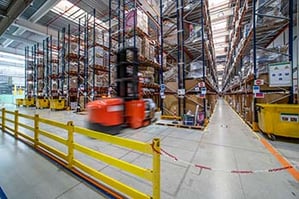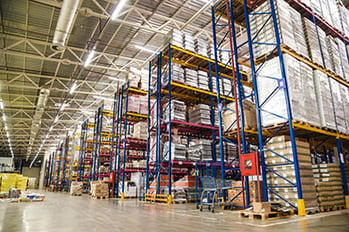 Peak season brings unique supply chain and operational challenges that are not experienced at other times of the year. The need to improve warehouse operations during non-peak times is critical. It can be very difficult to improve order fulfillment during the peak season. However, just because you can’t make changes, it doesn’t mean you shouldn’t be looking for changes to make.
Peak season brings unique supply chain and operational challenges that are not experienced at other times of the year. The need to improve warehouse operations during non-peak times is critical. It can be very difficult to improve order fulfillment during the peak season. However, just because you can’t make changes, it doesn’t mean you shouldn’t be looking for changes to make.
Labor is typically one of the largest distribution expense items, along with freight costs, for most companies. According to Indeed.com, the job employment website, the average base pay for warehouse workers is $16.78 in the U.S. However, when you factor in benefits such as healthcare, training and more – the fully loaded cost balloons to $28.86 per hour. Companies typically have the following costs over and above the base pay:
- Benefits and healthcare: 35% of payroll costs
- Workers comp and unemployment: 8% of payroll costs
- Training: 4% of payroll costs
- Recruitment, hiring and HR: 25% of payroll costs
One of the most important pieces to managing your operations is to understand how your workers are performing, how costs are trending, and what to do based on what the data is saying. For companies that are just beginning to implement metrics and KPIs, the task can seem daunting. For companies that have utilized benchmarking for quite some time, they might have benchmarking that needs to be reviewed and evaluated. Consider these 10 aspects to improve your internal benchmarking programs.
Read More > It is hard not to conclude that the US will be in the midst of another recession based on the economic indicators. How major the financial impact might be, or how long the recession might last is less clear. Building operational resilience and developing problem/solution scenarios prior to a recession will allow you to be more nimble and weather the impending economic downturn.
It is hard not to conclude that the US will be in the midst of another recession based on the economic indicators. How major the financial impact might be, or how long the recession might last is less clear. Building operational resilience and developing problem/solution scenarios prior to a recession will allow you to be more nimble and weather the impending economic downturn.
It is important to have a plan for addressing these challenges versus just hoping it does not occur. “Hope” is not a strategy. The key is to include the various department heads early in the discussions; identify areas that should be reviewed; and develop a course of action.
Based on previous recessions, we have compiled a list of areas where operations should proactively address.
Read More >
To say 2020 was a curveball most businesses would be a gross understatement. While Americans suffered and many small businesses closed permanently, multichannel businesses as a whole saw significantly higher volumes, largely from direct-to-customer orders. The difficulty was in trying to keep workers safe and have enough labor to ship customer orders without falling more than a few days behind. For some clients, the goal was to merely not fall more than 10-14 days behind.
Read More >Most companies want to improve their operations and become more efficient. The desire and need to improve is there. However, their systems are holding them back. FCBCO sees time and time again during operational assessments, the majority of the recommendations for becoming more efficient and moving to the next level operationally, cannot be implemented without implementing a new system. The right Warehouse Management System (WMS) for your company makes improvement possible through stronger functionality and improved warehousing processes.
Read More >In our consulting practice, we often hear the question "how does my cost per order compare to others". Management wants to be sure that the warehouse and distribution expenses are in line, and as efficient as possible. Companies typically benchmark against other warehouse and distribution center operations, to measure the performance of their company’s services, processes and metrics against those of another business. Companies also benchmark against the best in a specific industry (i.e. “best in class.”). The point of benchmarking is to identify internal opportunities for improvement as companies strive for continuous process improvement.
Read More >
Labor is continual challenge for most every business. Outside pressures from other businesses, as well as state governments are continually driving up labor costs. The latest example is from the retailing giant Target. On June 17th, Target announced that it will permanently raise its minimum wage for workers by $2, to $15 per hour starting next month. These cost increases will have a direct impact on your fulfillment cost per order.
Read More >In the ecommerce world of point, click and deliver, are you monitoring Direct To Customer (DTC) service level metrics that will help you meet the high expectations of customers?
Amazon has set high performance standards for fast delivery and little or no shipping cost. Amazon is already capable of offering same-day and one-day delivery to 82% of the total U.S. population, according to RBC Capital Markets. Their vast delivery network is a result of significant investments over the past four years, allowing same day delivery in hundreds of markets.
Read More >
There are many types of warehouse operational metrics you can use to measure the order throughput, inventory accuracy, cost of departmental operations and customer service.
For 34 years, F. Curtis Barry & Company has assisted clients in defining key metrics, how to measure the operational performance and implement best practices.
Continual process improvement is a principle many companies subscribe to, but they don’t have reliable data to measure productivity of current processes. Process improvement should begin with this principle: “If you have not measured it, you cannot improve it.”
SUBSCRIBE VIA EMAIL
Articles by Topic
- 3rd Party Logistics (3PL) (25)
- Automation & MHE (7)
- DC/Warehouse Layout & Design (15)
- Distribution & Supply Chain Insights (3)
- Distribution & Supply Chain Strategies (42)
- Managing Labor, Costs & Metrics (25)
- Operational Assessments (68)
- Spare Parts & Parts Warehouses (3)
- Systems Selection & Implementation (11)
- Transportation & Shipping (8)
- Warehouse Management Systems (19)


